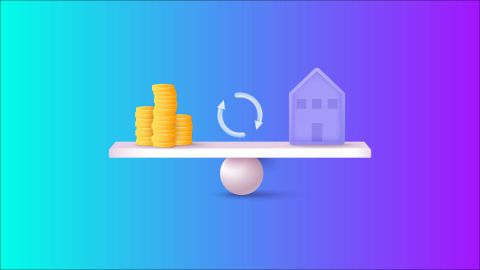यह आर्टिकल आपको मॉरगेज इंडस्ट्री की शब्दावली को डीक्रिप्ट करने और अपने लोन एप्लीकेशन को बहुत कम तनावपूर्ण बनाने में मदद करेगा.
सामान्य शब्द और एक्रोनिम
आपके रेफरेंस के लिए यहां होम लोन की सामान्य शर्तों और एक्रोनिम की पूरी शब्दावली दी गई है:
फ्लोटिंग रेट ब्याज होम लोन
यह स्कीम एक ब्याज दर प्रदान करती है जो समय-समय पर बदलती रहती है. आमतौर पर यह कितना बढ़ सकता है, इसकी ऊपरी सीमा होती है.
फिक्स्ड रेट होम लोन
फ्लोटिंग ब्याज दर वाले होम लोन के विपरीत, यह एक ब्याज दर है जो आपके होम लोन की अवधि के दौरान समान होती है.
बंद होने की लागत
यह ओरिजिनेशन फीस, अटॉर्नी की फीस, डॉक्यूमेंटेशन फीस आदि जैसे खर्चों को कवर करता है. आमतौर पर प्रॉपर्टी खरीदते समय खरीदार द्वारा इसका भुगतान किया जाता है.
कोलैटरल
यह वह प्रॉपर्टी या एसेट है जिसे उधारकर्ता लोनदाता को सिक्योरिटी के रूप में देता है. इसका मूल रूप से मतलब है कि अगर आप लोन का पुनर्भुगतान नहीं कर पाते हैं, तो लोनदाता को आपके द्वारा कोलैटरल के रूप में इस्तेमाल की गई एसेट पर स्वामित्व होगा.
ऋण मूल्यांकन
जब आप होम लोन के लिए अप्लाई करते हैं, तो लोन कंपनी आपके लिए बैकग्राउंड चेक करती है - आपका क्रेडिट स्कोर, मासिक आय, बचत और अन्य लोन का विश्लेषण किया जाता है. यह उन्हें लोन के लिए आपकी योग्यता निर्धारित करने में मदद करता है, आप कितना लोन के लिए योग्य हैं. इस पूरी प्रोसेस को क्रेडिट अप्रेज़ल कहा जाता है.
डिस्बर्समेंट
यह वह शब्द है जिसका उपयोग फाइनेंशियल संस्थान से उधारकर्ता को लोन जारी करने की जानकारी देने के लिए किया जाता है
डाउन पेमेंट/मार्जिन
भारतीय रिज़र्व बैंक के अनुसार, जब आप प्रॉपर्टी खरीदते हैं, तो आप प्रॉपर्टी की वैल्यू का 80% तक का लोन ले सकते हैं. शेष 20% का भुगतान आपको सीधे करना होगा. इस राशि को डाउन पेमेंट कहा जाता है.
समान मासिक किश्तों
EMI एक संक्षिप्त नाम है जिसे हम अक्सर सुनते हैं. EMI को उस राशि के रूप में परिभाषित किया जाता है जिसे आप हर महीने अपने लोनदाता को चुकाते हैं. यह मूल लोन राशि के साथ-साथ बकाया ब्याज दोनों को मिलाता है. कुछ फाइनेंसर आपको तीन EMI-मुक्त महीने प्रदान करते हैं ताकि आपको फाइनेंशियल सहायता मिल सके, अगर आपको इसकी आवश्यकता हो.
फोरक्लोज़र
लोन की अवधि समाप्त होने से पहले अपने लोन का पूरी तरह से भुगतान करना फोरक्लोज़र के नाम से जाना जाता है.
संयुक्त स्वामित्व
यह तब होता है जब दो व्यक्ति, आमतौर पर पति/पत्नी, एक साथ प्रॉपर्टी खरीदते हैं.
लोन-टू-वैल्यू रेशियो (LVR)
लोन-टू-वैल्यू (LTV) रेशियो लेंडिंग में एक बुनियादी अवधारणा है, विशेष रूप से मॉरगेज इंडस्ट्री में. यह लोन के माध्यम से फाइनेंस की गई प्रॉपर्टी की वैल्यू का प्रतिशत दर्शाता है और जोखिम का आकलन करने, ब्याज दरों को निर्धारित करने और लोन अप्रूवल के निर्णयों को प्रभावित करने में महत्वपूर्ण भूमिका निभाता है. प्रॉपर्टी खरीदने के लिए फाइनेंसिंग मांगते समय उधारकर्ता और रियल एस्टेट इन्वेस्टर को LTV रेशियो के प्रभावों के बारे में जानकारी होनी चाहिए.
लॉक-इन अवधि
कई संस्थानों के पास एक खंड है जो बताता है कि उधारकर्ता को निश्चित वर्षों के लिए उनके साथ रहना चाहिए. अगर आप उस अवधि से पहले लोनदाता को बदलने का निर्णय लेते हैं, तो आपको दंड शुल्क का भुगतान करना पड़ सकता है.
मेच्योरिटी
यह होम लोन का जीवनकाल है, जिसके भीतर लोन का पुनर्भुगतान किया जाना चाहिए.
पोस्ट-डेटेड चेक (PDC)
ये चेक भविष्य की तिथियों के साथ हैं. उल्लिखित तिथि से पहले इन्हें प्रोसेस नहीं किया जा सकता है. कई लोनदाता उधारकर्ताओं से एक वर्ष की पीडीसी की आपूर्ति के लिए पूछते हैं, जिनके पास EMI राशि और उनके हस्ताक्षर होते हैं.
रीसेल
इसका मतलब है कि आप ऐसी प्रॉपर्टी खरीद रहे हैं जो पहले किसी और के स्वामित्व में है. शब्द का उपयोग करने का अर्थ है कि आप प्रॉपर्टी का पहला मालिक नहीं हैं और आपने इसे बिल्डर से नहीं खरीदा है. ऐसे मामलों में, विक्रेता से प्रॉपर्टी के सभी फाइनेंशियल रिकॉर्ड सौंपने के लिए कहें. अधिकांश लोग भारत में होम लोन की शर्तों के बारे में नहीं जानते हैं. अगर आप मॉरगेज की शर्तों और शर्तों के बारे में बिना किसी जानकारी के लोन के लिए अप्लाई करते हैं, तो हो सकता है कि आप सर्वश्रेष्ठ डील प्राप्त नहीं कर पाएंगे. इसलिए, पहले महत्वपूर्ण शर्तों को समझें, कुछ अतिरिक्त रिसर्च करें, और फिर अपनी ज़रूरतों के अनुसार होम लोन के लिए अप्लाई करें.
अस्वीकरण:
हांलाकि यहां शामिल या उपलब्ध जानकारी, प्रोडक्ट और सेवाओं को अपडेट करने में सावधानी बरती जाती है हमारी वेबसाइट और संबंधित प्लेटफॉर्म/वेबसाइट, जानकारी को अपडेट करने में अनुचित गलतियां या टाइपोग्राफिकल एरर या देरी हो सकती है. इस साइट और संबंधित वेबपेजों में शामिल सामग्री संदर्भ और सामान्य जानकारी के उद्देश्य के लिए है और किसी भी असंगति की स्थिति में संबंधित प्रोडक्ट/सेवा डॉक्यूमेंट में उल्लिखित विवरण का पालन किया जाएगा. सब्सक्राइबर्स और यूज़र्स को यहां दी गई जानकारी के आधार पर आगे बढ़ने से पहले प्रोफेशनल सलाह लेनी चाहिए. कृपया संबंधित प्रोडक्ट/सेवा डॉक्यूमेंट और लागू नियमों और शर्तों को पढ़ने के बाद ही किसी भी प्रोडक्ट या सेवा के बारे में सोच-समझकर निर्णय लें. अगर कोई विसंगति दिखाई देती है, तो कृपया यहां क्लिक करें संपर्क जानकारी.
*नियम व शर्तें लागू




